[English] 日本語
 Yorodumi
Yorodumi- PDB-3vxm: The complex between C1-28 TCR and HLA-A24 bound to HIV-1 Nef134-1... -
+ Open data
Open data
- Basic information
Basic information
| Entry | Database: PDB / ID: 3vxm | ||||||
|---|---|---|---|---|---|---|---|
| Title | The complex between C1-28 TCR and HLA-A24 bound to HIV-1 Nef134-10(2F) peptide | ||||||
 Components Components |
| ||||||
 Keywords Keywords | IMMUNE SYSTEM / HIV-1 / NEF / HLA-A24 / T CELL RECEPTOR / MHC CLASS I / IMMUNOGLOBURIN DOMAIN / TCR / MHC / IMMUNE RESPONSE | ||||||
| Function / homology |  Function and homology information Function and homology informationsymbiont-mediated suppression of host antigen processing and presentation of peptide antigen via MHC class I / symbiont-mediated suppression of host antigen processing and presentation of peptide antigen via MHC class II / symbiont-mediated suppression of host autophagy / positive regulation of memory T cell activation / T cell mediated cytotoxicity directed against tumor cell target / TAP complex binding / Golgi medial cisterna / positive regulation of CD8-positive, alpha-beta T cell activation / CD8-positive, alpha-beta T cell activation / positive regulation of CD8-positive, alpha-beta T cell proliferation ...symbiont-mediated suppression of host antigen processing and presentation of peptide antigen via MHC class I / symbiont-mediated suppression of host antigen processing and presentation of peptide antigen via MHC class II / symbiont-mediated suppression of host autophagy / positive regulation of memory T cell activation / T cell mediated cytotoxicity directed against tumor cell target / TAP complex binding / Golgi medial cisterna / positive regulation of CD8-positive, alpha-beta T cell activation / CD8-positive, alpha-beta T cell activation / positive regulation of CD8-positive, alpha-beta T cell proliferation / CD8 receptor binding / antigen processing and presentation of exogenous peptide antigen via MHC class I / beta-2-microglobulin binding / endoplasmic reticulum exit site / TAP binding / antigen processing and presentation of endogenous peptide antigen via MHC class I via ER pathway, TAP-dependent / protection from natural killer cell mediated cytotoxicity / host cell Golgi membrane / antigen processing and presentation of endogenous peptide antigen via MHC class I via ER pathway, TAP-independent / antigen processing and presentation of endogenous peptide antigen via MHC class Ib / detection of bacterium / T cell receptor binding / negative regulation of receptor binding / early endosome lumen / Nef mediated downregulation of MHC class I complex cell surface expression / DAP12 interactions / transferrin transport / cellular response to iron ion / Endosomal/Vacuolar pathway / lumenal side of endoplasmic reticulum membrane / Antigen Presentation: Folding, assembly and peptide loading of class I MHC / peptide antigen assembly with MHC class II protein complex / cellular response to iron(III) ion / MHC class II protein complex / negative regulation of forebrain neuron differentiation / antigen processing and presentation of exogenous protein antigen via MHC class Ib, TAP-dependent / ER to Golgi transport vesicle membrane / peptide antigen assembly with MHC class I protein complex / regulation of iron ion transport / regulation of erythrocyte differentiation / HFE-transferrin receptor complex / response to molecule of bacterial origin / MHC class I peptide loading complex / T cell mediated cytotoxicity / positive regulation of T cell cytokine production / antigen processing and presentation of endogenous peptide antigen via MHC class I / antigen processing and presentation of exogenous peptide antigen via MHC class II / positive regulation of immune response / MHC class I protein complex / positive regulation of T cell activation / peptide antigen binding / positive regulation of receptor-mediated endocytosis / negative regulation of neurogenesis / SH3 domain binding / cellular response to nicotine / positive regulation of T cell mediated cytotoxicity / multicellular organismal-level iron ion homeostasis / virion component / specific granule lumen / positive regulation of type II interferon production / phagocytic vesicle membrane / recycling endosome membrane / Interferon gamma signaling / Immunoregulatory interactions between a Lymphoid and a non-Lymphoid cell / negative regulation of epithelial cell proliferation / MHC class II protein complex binding / Interferon alpha/beta signaling / Modulation by Mtb of host immune system / late endosome membrane / sensory perception of smell / positive regulation of cellular senescence / antibacterial humoral response / tertiary granule lumen / DAP12 signaling / T cell differentiation in thymus / T cell receptor signaling pathway / E3 ubiquitin ligases ubiquitinate target proteins / negative regulation of neuron projection development / ER-Phagosome pathway / protein refolding / early endosome membrane / protein homotetramerization / amyloid fibril formation / intracellular iron ion homeostasis / learning or memory / defense response to Gram-positive bacterium / immune response / endoplasmic reticulum lumen / Amyloid fiber formation / signaling receptor binding / Golgi membrane / lysosomal membrane / innate immune response / external side of plasma membrane / focal adhesion / Neutrophil degranulation / endoplasmic reticulum membrane / GTP binding / SARS-CoV-2 activates/modulates innate and adaptive immune responses / host cell plasma membrane Similarity search - Function | ||||||
| Biological species |  Homo sapiens (human) Homo sapiens (human)  Human immunodeficiency virus 1 Human immunodeficiency virus 1 | ||||||
| Method |  X-RAY DIFFRACTION / X-RAY DIFFRACTION /  SYNCHROTRON / SYNCHROTRON /  MOLECULAR REPLACEMENT / Resolution: 2.5 Å MOLECULAR REPLACEMENT / Resolution: 2.5 Å | ||||||
 Authors Authors | Shimizu, A. / Fukai, S. / Yamagata, A. / Iwamoto, A. | ||||||
 Citation Citation |  Journal: SCI REP / Year: 2013 Journal: SCI REP / Year: 2013Title: Structure of TCR and antigen complexes at an immunodominant CTL epitope in HIV-1 infection Authors: Shimizu, A. / Kawana-Tachikawa, A. / Yamagata, A. / Han, C. / Zhu, D. / Sato, Y. / Nakamura, H. / Koibuchi, T. / Carlson, J. / Martin, E. / Brumme, C.J. / Shi, Y. / Gao, G.F. / Brumme, Z.L. ...Authors: Shimizu, A. / Kawana-Tachikawa, A. / Yamagata, A. / Han, C. / Zhu, D. / Sato, Y. / Nakamura, H. / Koibuchi, T. / Carlson, J. / Martin, E. / Brumme, C.J. / Shi, Y. / Gao, G.F. / Brumme, Z.L. / Fukai, S. / Iwamoto, A. | ||||||
| History |
|
- Structure visualization
Structure visualization
| Structure viewer | Molecule:  Molmil Molmil Jmol/JSmol Jmol/JSmol |
|---|
- Downloads & links
Downloads & links
- Download
Download
| PDBx/mmCIF format |  3vxm.cif.gz 3vxm.cif.gz | 184.6 KB | Display |  PDBx/mmCIF format PDBx/mmCIF format |
|---|---|---|---|---|
| PDB format |  pdb3vxm.ent.gz pdb3vxm.ent.gz | 143.8 KB | Display |  PDB format PDB format |
| PDBx/mmJSON format |  3vxm.json.gz 3vxm.json.gz | Tree view |  PDBx/mmJSON format PDBx/mmJSON format | |
| Others |  Other downloads Other downloads |
-Validation report
| Summary document |  3vxm_validation.pdf.gz 3vxm_validation.pdf.gz | 462.8 KB | Display |  wwPDB validaton report wwPDB validaton report |
|---|---|---|---|---|
| Full document |  3vxm_full_validation.pdf.gz 3vxm_full_validation.pdf.gz | 480 KB | Display | |
| Data in XML |  3vxm_validation.xml.gz 3vxm_validation.xml.gz | 33.9 KB | Display | |
| Data in CIF |  3vxm_validation.cif.gz 3vxm_validation.cif.gz | 47.7 KB | Display | |
| Arichive directory |  https://data.pdbj.org/pub/pdb/validation_reports/vx/3vxm https://data.pdbj.org/pub/pdb/validation_reports/vx/3vxm ftp://data.pdbj.org/pub/pdb/validation_reports/vx/3vxm ftp://data.pdbj.org/pub/pdb/validation_reports/vx/3vxm | HTTPS FTP |
-Related structure data
| Related structure data |  3vxnSC  3vxoC  3vxpC  3vxqC  3vxrC  3vxsC  3vxtC  3vxuC  3w0wC  3tpuS S: Starting model for refinement C: citing same article ( |
|---|---|
| Similar structure data |
- Links
Links
- Assembly
Assembly
| Deposited unit | 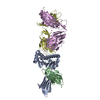
| ||||||||
|---|---|---|---|---|---|---|---|---|---|
| 1 |
| ||||||||
| Unit cell |
|
- Components
Components
-Protein , 4 types, 4 molecules ABDE
| #1: Protein | Mass: 31683.086 Da / Num. of mol.: 1 / Fragment: UNP residues 25-298 Source method: isolated from a genetically manipulated source Source: (gene. exp.)  Homo sapiens (human) / Gene: HLA-A / Plasmid: PET21D(+) / Production host: Homo sapiens (human) / Gene: HLA-A / Plasmid: PET21D(+) / Production host:  |
|---|---|
| #2: Protein | Mass: 11879.356 Da / Num. of mol.: 1 Source method: isolated from a genetically manipulated source Source: (gene. exp.)  Homo sapiens (human) / Gene: B2M / Plasmid: PET21A(+) / Production host: Homo sapiens (human) / Gene: B2M / Plasmid: PET21A(+) / Production host:  |
| #4: Protein | Mass: 23243.758 Da / Num. of mol.: 1 Source method: isolated from a genetically manipulated source Source: (gene. exp.)  Homo sapiens (human) / Plasmid: PET21A(+) / Production host: Homo sapiens (human) / Plasmid: PET21A(+) / Production host:  |
| #5: Protein | Mass: 27819.344 Da / Num. of mol.: 1 Source method: isolated from a genetically manipulated source Source: (gene. exp.)  Homo sapiens (human) / Plasmid: PET21D(+) / Production host: Homo sapiens (human) / Plasmid: PET21D(+) / Production host:  |
-Protein/peptide , 1 types, 1 molecules C
| #3: Protein/peptide | Mass: 1274.511 Da / Num. of mol.: 1 / Source method: obtained synthetically / Details: Synthetic peptide / Source: (synth.)   Human immunodeficiency virus 1 / References: UniProt: Q9YYU3 Human immunodeficiency virus 1 / References: UniProt: Q9YYU3 |
|---|
-Non-polymers , 2 types, 277 molecules 


| #6: Chemical | | #7: Water | ChemComp-HOH / | |
|---|
-Details
| Has protein modification | Y |
|---|---|
| Sequence details | THE FIRST RESIDUE MET IN CHAIN D, E IS EXPRESSION |
-Experimental details
-Experiment
| Experiment | Method:  X-RAY DIFFRACTION / Number of used crystals: 1 X-RAY DIFFRACTION / Number of used crystals: 1 |
|---|
- Sample preparation
Sample preparation
| Crystal | Density Matthews: 2.66 Å3/Da / Density % sol: 53.79 % |
|---|---|
| Crystal grow | Temperature: 293 K / Method: vapor diffusion, sitting drop / pH: 7.5 Details: 80mM HEPES, 8mM Cobalt(II) chloride hexahydrate, 8% PEG 6000, 4% 2-Methyl-2,4-pentanediol (MPD), 8mM betaine hydrochloride, pH 7.5, VAPOR DIFFUSION, SITTING DROP, temperature 293K |
-Data collection
| Diffraction | Mean temperature: 100 K |
|---|---|
| Diffraction source | Source:  SYNCHROTRON / Site: SYNCHROTRON / Site:  SPring-8 SPring-8  / Beamline: BL41XU / Wavelength: 1 Å / Beamline: BL41XU / Wavelength: 1 Å |
| Detector | Type: RAYONIX MX225HE / Detector: CCD / Date: Apr 12, 2012 |
| Radiation | Protocol: SINGLE WAVELENGTH / Monochromatic (M) / Laue (L): M / Scattering type: x-ray |
| Radiation wavelength | Wavelength: 1 Å / Relative weight: 1 |
| Reflection | Resolution: 2.5→50 Å / Num. obs: 35806 / % possible obs: 99.2 % / Observed criterion σ(I): 0 / Redundancy: 5.8 % / Rsym value: 0.068 / Net I/σ(I): 32.8 |
| Reflection shell | Resolution: 2.5→2.59 Å / Redundancy: 4.5 % / Mean I/σ(I) obs: 6.26 / Num. unique all: 3440 / Rsym value: 0.219 / % possible all: 98.4 |
- Processing
Processing
| Software |
| ||||||||||||||||||||||||||||||||||||||||||||||||||||||||||||||||||||||||||||||||||||||||||||||||||||||||||||||||||||||||||||||||||||||||||||||||||||||||||||||||||||||||||
|---|---|---|---|---|---|---|---|---|---|---|---|---|---|---|---|---|---|---|---|---|---|---|---|---|---|---|---|---|---|---|---|---|---|---|---|---|---|---|---|---|---|---|---|---|---|---|---|---|---|---|---|---|---|---|---|---|---|---|---|---|---|---|---|---|---|---|---|---|---|---|---|---|---|---|---|---|---|---|---|---|---|---|---|---|---|---|---|---|---|---|---|---|---|---|---|---|---|---|---|---|---|---|---|---|---|---|---|---|---|---|---|---|---|---|---|---|---|---|---|---|---|---|---|---|---|---|---|---|---|---|---|---|---|---|---|---|---|---|---|---|---|---|---|---|---|---|---|---|---|---|---|---|---|---|---|---|---|---|---|---|---|---|---|---|---|---|---|---|---|---|---|
| Refinement | Method to determine structure:  MOLECULAR REPLACEMENT MOLECULAR REPLACEMENTStarting model: 3TPU, 3VXN Resolution: 2.5→50 Å / Cor.coef. Fo:Fc: 0.923 / Cor.coef. Fo:Fc free: 0.875 / SU B: 9.056 / SU ML: 0.206 / Cross valid method: THROUGHOUT / ESU R: 0.561 / ESU R Free: 0.309 / Stereochemistry target values: MAXIMUM LIKELIHOOD / Details: HYDROGENS HAVE BEEN USED IF PRESENT IN THE INPUT
| ||||||||||||||||||||||||||||||||||||||||||||||||||||||||||||||||||||||||||||||||||||||||||||||||||||||||||||||||||||||||||||||||||||||||||||||||||||||||||||||||||||||||||
| Solvent computation | Ion probe radii: 0.8 Å / Shrinkage radii: 0.8 Å / VDW probe radii: 1.2 Å / Solvent model: MASK | ||||||||||||||||||||||||||||||||||||||||||||||||||||||||||||||||||||||||||||||||||||||||||||||||||||||||||||||||||||||||||||||||||||||||||||||||||||||||||||||||||||||||||
| Displacement parameters | Biso mean: 35.186 Å2
| ||||||||||||||||||||||||||||||||||||||||||||||||||||||||||||||||||||||||||||||||||||||||||||||||||||||||||||||||||||||||||||||||||||||||||||||||||||||||||||||||||||||||||
| Refinement step | Cycle: LAST / Resolution: 2.5→50 Å
| ||||||||||||||||||||||||||||||||||||||||||||||||||||||||||||||||||||||||||||||||||||||||||||||||||||||||||||||||||||||||||||||||||||||||||||||||||||||||||||||||||||||||||
| Refine LS restraints |
| ||||||||||||||||||||||||||||||||||||||||||||||||||||||||||||||||||||||||||||||||||||||||||||||||||||||||||||||||||||||||||||||||||||||||||||||||||||||||||||||||||||||||||
| LS refinement shell | Resolution: 2.5→2.565 Å / Total num. of bins used: 20
|
 Movie
Movie Controller
Controller


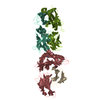
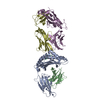
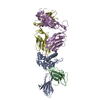
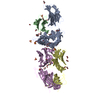
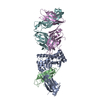
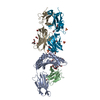
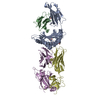
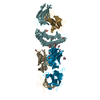
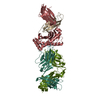
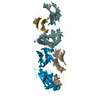
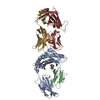
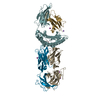

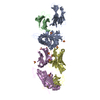

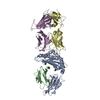
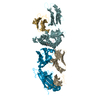
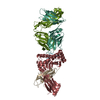
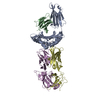
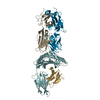
 PDBj
PDBj




